Growing Tahitian Vanilla
Learn about the process of growing Tahitian vanilla to understand why this highly prized, delicate, and versatile spice is worth buying, even though it costs more than artificial vanillin.
Vanilla seeds will not germinate in the absence of specific mycorrhizal fungi so growing Tahitian vanilla begins by taking plant cuttings with at least 6 leaf nodes.
In the wild the vanilla vine grows up already established plants, for support. Forty percent of farms growing Tahitian vanilla are still planting in this natural style and sixty percent have huge shade houses where the vines are trained to grow up posts, which is more efficient, but the romance is lost.
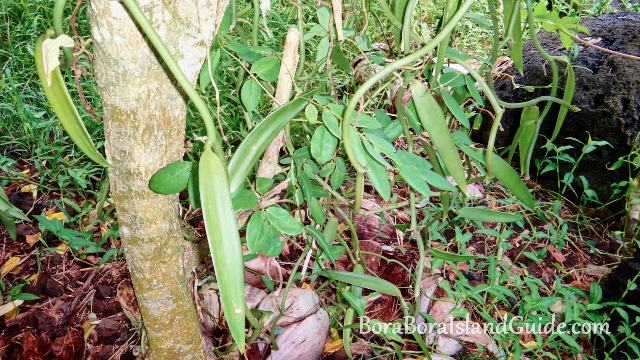 A vanilla vine growing up an established tree
A vanilla vine growing up an established treeTo thrive, vanilla plants need a hot, humid climate; 50% shade; and
nutrient-rich, organic compost on a loamy, well-drained soil. The ideal
time to plant vanilla cuttings is from September to November. The first
flowers bloom 3 years later. If a flower is fertilized, a bean begins to
develop in 5 to 6 weeks and takes 6 months to mature. Each vine
produces pods for 12 to 14 years.
Untended, the vanilla vine
will grow as high as it's support allows but produce few flowers.
Farmers have learned to fold the high parts of the plant down to
stimulate flowering, and this also keeps the beans accessible to
pickers.
Each vanilla flower has both male and female organs,
separated by a membrane which prevents self pollination. This mysterious
structure prevented entrepreneurs from growing Tahitan vanilla outside
of Mexico for hundreds of years, as pollination was done by only one
species of local bee. Now a farm worker simply uses a sliver of bevilled
bamboo to lift the fine shield between the anther and the stigma, then
transfers pollinia from the male anther to the female stigma with a
thumb.
Tahitian vanilla orchids flower during the months of June
to September, which is summer in Tahiti. Every plant must be checked
daily, starting early in the morning, as each flower only last about 6
hours.
Disease and Pest Control
Perfect conditions are necessary for growing Tahitian vanilla successfully. Excess water without sufficient drainage, over-pollination, and too much shade, make it susceptible to fungal and viral diseases, which can be controlled with sprays or biological means. Diseases are spread through the sap so all affected plants must be destroyed.
Pests must be managed. Insects can attack the flowers. Caterpillars and slugs eat young, tender shoots, buds, and fruit. And grasshoppers may damage the shoot tips on new cuttings. It's easier to implement organic methods of growing Tahitian vanilla in shade-houses where there is greater control over the environment.
Harvesting and Processing
The fruit pods are picked when a pale yellow discoloration occurs on their dark green surface. For maximum flavor, each bean is picked as it ripens. So harvesting is a time consuming daily task, just like the pollinating process.
Killing
To stop growth and create enzymatic reactions, which release the fragrance, the harvested Tahitian vanilla pods are washed in cold water and heated in the sun or an oven.
Sweating & Drying
Traditionally, Tahitian vanilla beans are placed on hot metal sheets and exposed to the hot sun from 10am until noon. Next they're wrapped in cloth or paper and placed in large wooden boxes to sweat. This is repeated daily until they have lost 65% to 70% of their moisture.
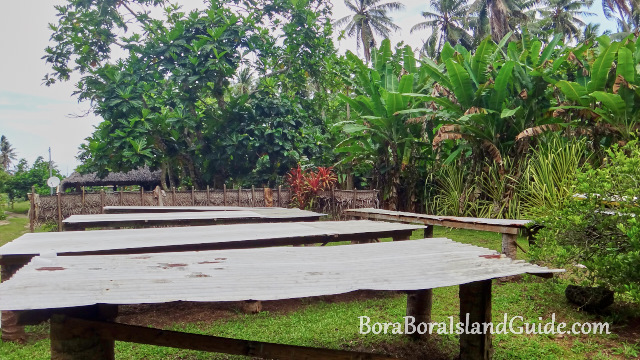 Tahitian vanilla beans are layed out over the hot metal to dry in the sun
Tahitian vanilla beans are layed out over the hot metal to dry in the sunToday some producers growing Tahitian vanilla spread beans on wooden
racks in a hot room, for up to a month. This avoids the inconvenience
of rain. During this stage some sun exposure may be incorporated.
Beans
are first sorted according to their size so that they dry evenly. This
prevents some from losing their precious vanillin content while the
larger ones are still drying. Drying is a critical process to prevent
them rotting and seals in the aroma.
Conditioning
Next the pods are placed in sealed wooden boxes for 6 months while the fragrance develops.
Grading
Tahitian vanilla pods are graded according to the European standard:
- Grade A beans are also called 'Gourmet'. These whole, dark, plump, oily pods over 15 centimeters long, with a moisture content of 30 to 35% are valued most highly, and classed as export quality. They are favored by chefs around the world, who feature them creatively in gourmet dishes.
- Grade B beans are curved, short, or have a low moisture content, which means some of their essence has been lost. They're ground into powder or made into vanilla extract.
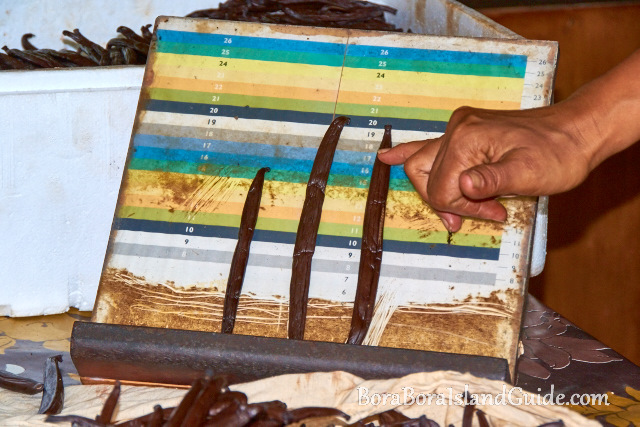 Grading the length of the vanilla beans
Grading the length of the vanilla beansWhere to buy Tahitian vanilla
Look out for the little sealed bags of top grade, export quality beans for sale at Papeete markets in Tahiti. Don't be phased by the cost as the prices represent honest labor. If you buy vanilla beans at a farm you'll pay a slightly cheaper price.
Learn More About the world's second most pricey spice
Visit a Tahitian vanilla farm to learn about growing Tahitian vanilla and buy superb vanilla beans for the best price.
Know how to cook with this versatile spice by exploring the many culinary uses of Tahitian vanilla.
Peek into the history of Tahitian vanilla and you'll find it's as exotic as the spice.
Home › Tahitian Vanilla › Growing Tahitian Vanilla
Search the Site
Are you still looking for additional information? You can use the Google search box below to search the site.
Site Sponsors
Subscribe to receive free Bora Bora updates
Top Tours
Photo of the day
All of us at Bora Bora Island guide love to have fun, but we also have to keep the site up and running! That's why you'll see ads on this site. We may also earn commissions on some of the products on this site.
The income generated through these means helps ensure
Bora Bora Island Guide can devote the time to providing you
with all the free and fabulous information & resources you'll
find here. If you would like to support us, you can purchase our book full of over 100 pages of money saving tips or find out the best activities, resorts, dining and beaches in our Best of Bora Bora book or buy our 2018 Bora Bora calendar.
Want to learn more? Bora Bora Island Guide invites you to read our advertising disclosure.










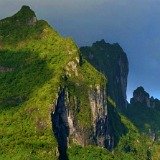
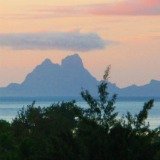
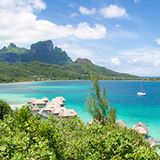





New! Comments
Have your say about what you just read! Leave me a comment in the box below.